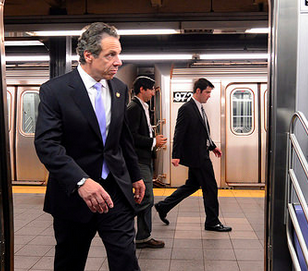Transportation Commissioner Polly Trottenberg said today that the MTA is making "optimistic assumptions" about federal funding as it plans its next five-year capital program. The agency has identified only half the funds to cover the projected costs of the plan, which maintains, upgrades, and expands the transit system. At a panel with top-level city agency heads this morning, Trottenberg, who sits on the MTA board, warned about a possible cut in federal support, which would further widen the funding gap.

A drop in federal funds would supposedly increase pressure on Governor Andrew Cuomo, who controls the transit authority, to support new sources of revenue. So far, the governor has opposed any new revenue for the MTA.
This morning's panel, which kicked off the annual meeting of the American Planning Association's New York Metro chapter, featured Trottenberg, City Planning Commission Chair Carl Weisbrod, HPD Commissioner Vicki Been, and EDC President Kyle Kimball. It was moderated by Regional Plan Association Executive Director Tom Wright.
Trottenberg, who was a top U.S. DOT official before moving to NYC government, questioned the assumptions the MTA is making about the federal contribution to its capital program. “At the moment, they have half the funds in hand,” she said. “I’m not even quite sure that they have that money in hand, because it does make some optimistic assumptions perhaps about what’s happening at the federal level.”
After the event, I asked Trottenberg why she thought the MTA's assumptions are optimistic. She took a long pause before answering. "There is a big question mark about what the federal funding picture is going to look like in the next few years, and understandably when you’re doing a capital budget you have to take a guess at a number," she said. "But I think there’s a chance that the feds are going to be even less supportive on the transit front than they have been in the past."
Many political analysts expect Republicans to gain control of the Senate in November, which could disrupt the current stasis in federal transportation policy.
While Trottenberg raised the possibility of a decrease in federal support for transit, the MTA expects those funds to remain steady [PDF].
To be precise, MTA is projecting $6.275 billion in federal support for the next capital plan. The previous capital plan received $5.975 billion from the feds [PDF]. The MTA says the number jumped by $300 million because federal aid increased under the latest federal transportation bill, which passed after the last capital plan was adopted. The MTA assumes the increased funding level will continue under the next transportation bill.
A drop in federal aid under a new Congress would widen the capital program's funding gap and increase the urgency to enact new funding sources. When Crain's asked about congestion pricing or toll reform in July, Trottenberg said the city hadn't "ruled it out... [or] ruled it in." I asked Trottenberg for her opinion of toll reform today. "The discussion is underway. You’ve heard the governor’s first thoughts on it," she said, referring to Governor Andrew Cuomo's remarks that the capital plan is "bloated" and that the MTA does not need new revenue.
"Now it’s going to be a process that’s going to involve the political actors up in Albany," Trottenberg said, "and keeping an eye on what happens at the federal level."
I asked again if she had an opinion on toll reform as a revenue source for the MTA. "Not today," she said.
During the panel, Weisbrod said the city is interested in using real estate development to provide funding for transit improvements, a strategy known as "value capture" that Trottenberg has suggested before. "We're going to see that, I hope, in our East Midtown project… where we'll see development that will commit $250 million to the Lexington Avenue subway station," Weisbrod said. "Once it goes through [the city's land use review process], it will be one of the more secure parts of the capital budget." The audience chuckled.
Development tied to the city's most recent value capture project, the 7 train extension to Hudson Yards, has struggled to meet expectations. As a result, city taxpayers have spent millions on a project that was originally supposed to be paid for by developers.
Another issue on Weisbrod's plate: parking reform. In May, he was cautious about reforming the city's parking mandates. After today's event, I asked about it again. While he didn't take a more aggressive stance, Weisbrod hinted that DCP would take action soon. "We're literally looking at parking right now, particularly parking in neighborhoods where there's good transit," he said. "And [we're looking at] affordability in terms of reducing parking requirements."
The de Blasio administration currently focusing its effort to add more housing in East New York. “The Department of Transportation is integral to our efforts in East New York," Weisbrod said. “[DOT] has committed resources to really improving the streetscape on Atlantic Avenue, which is central to creating a new neighborhood."
Trottenberg said that while the area has some of the city's most dangerous streets, East New York and other low-income neighborhoods do not have the same level of community engagement as wealthier areas. She described putting two maps side-by-side, one showing crashes and fatalities and another showing suggestions the department gathered online and at workshops. "The two maps did not match," she said. "The Brooklyn Heights, Park Slope map was full of a lot of people having ideas [but are] very safe, relatively speaking. [Poorer] neighborhoods -- Brownsville, you name it -- had much higher fatality and crash rates, but much less engagement."
De Blasio has made equity a centerpiece of his administration. "I am now trying to redeploy the resources in my agency," Trottenberg said, "to spend the time in neighborhoods where you really have to work a little harder to get engagement."





